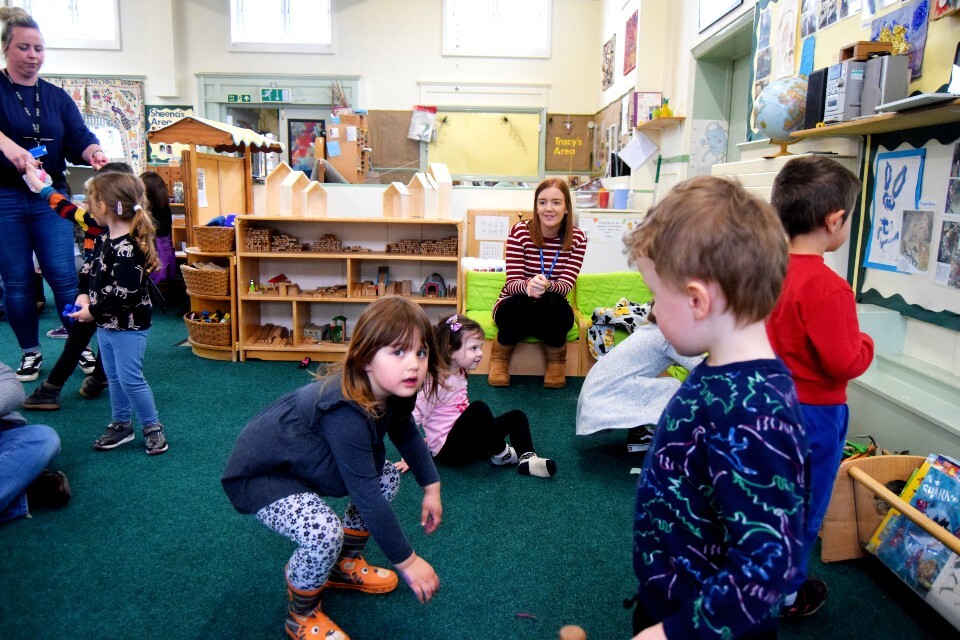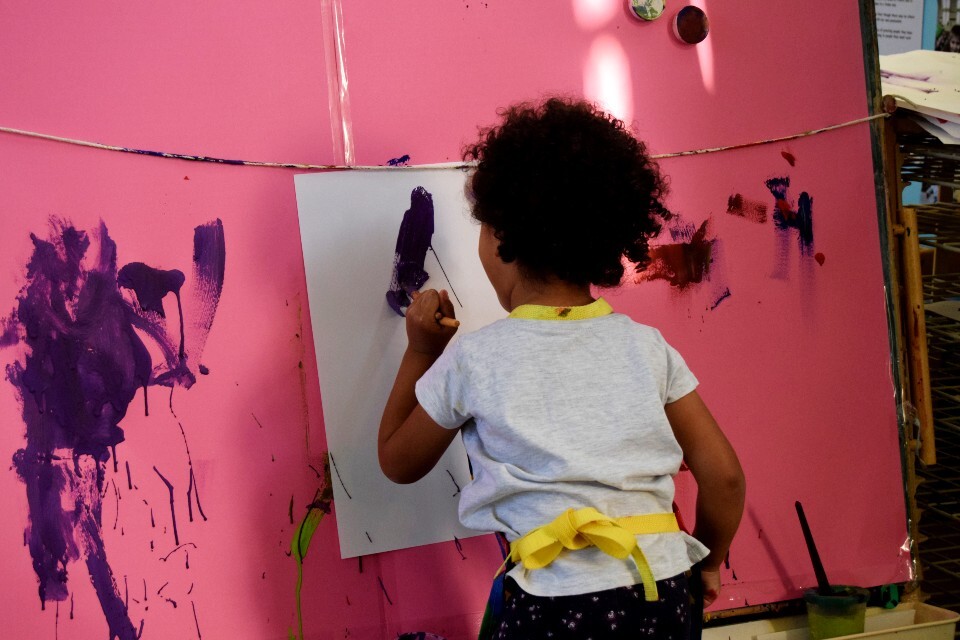Communicating through arts
You can support children's wellbeing in early years by giving them the ability to communicate through arts.
Contents on this page
Why communicating through arts is important
Communication and expression are the ways children share their responses to what they see, hear and experience. Creative expression supports children’s emotional wellbeing and reduces anxiety. It’s how children represent themselves, their thoughts and feelings as they develop their ideas.
Self-expression is children’s way of showing what they understand and know, through exploring:
- materials
- painting
- sculpting
- singing
- dancing
- roleplaying
Children with English as an additional language may find creative expression becomes their first way of communication in your setting.
Children can express their feelings through dance. Children will show confidence in the way they can move their whole bodies as well as isolate movements with their arms, hands, legs and feet. Older children are able to express themselves in the way they use materials for art and design.
Children are aware of performance from a young age. They understand what it means to have a performer and an audience. Some children have a need to ‘perform’ every day and will find a performance area for themselves, inside or outside.
When you respond to children’s self-expression you gain an insight into their thoughts and experiences. It allows you to respond by praising, mirroring, repeating and considering what they are doing.
Video
In this video, an early years expert explains the importance of communicating through arts in the early years foundation stage framework. There are also some tips on how to support children in this area.
What the EYFS framework says
The quality and variety of what children see, hear and participate in is crucial for developing their understanding, self-expression, vocabulary and ability to communicate through the arts.
Statutory framework for the early years foundation stage.
What this means in practice
Arts should be introduced as early as possible. For babies, exposure to music, art, movement and dance is a multi-sensory experience. For example, babies are aware in their first few days of a screen in the room at home.
Observe very young children and see how they respond to colours, lights, reflections, sounds and noise in your setting. Tuff trays are a good resource for giving very young children tactile experiences that they can immerse themselves in.
In practice, creative expression takes place when children are given time and space with reassurance and encouragement from adults. Avoid asking direct ‘outcome’ based questions like ‘what are you making?’ or ‘what is it?’ Young minds do not operate creatively in that way. Instead describe what you see, colours, shapes, movement, materials, sounds, lines or feelings, providing rich language for the child.
You can model skills such as cutting with scissors, but this must be carefully balanced with giving children the freedom to express themselves. Children may need to be taught to use these types of tools in order to support their self-expression.
Suggested activities
Communication through music

Ask the children to tell you their favourite song to listen, move, dance or sing to at home. It could be one for each child in a nursery or a whole set of favourites for a childminder.
Make a playlist of the songs for the children to listen to in different situations, for example while having a snack, playing, or playing outside.
Give them time to listen to the songs and respond to them. Notice these responses (verbal, movements and gestures). Let them have a ‘disco time’ where they have a chance to respond through movement to the music. If there are any action songs or rhymes in the playlist make sure you give the children the opportunity to practice these to the music. Allow for children to lead others and teach the moves.
Make a list of the songs to give parents so they too can become familiar with the songs and enjoy listening, moving and talking about them at home.
Pick one song from the list and ask them to switch on their ‘listening ears’. Talk about which child likes this song. Share with the children anything you have noticed about how they have responded to it while it has been played. Is there a chorus and a verse in the song? Use musical language to reinforce their findings (loud, fast, changing tempo, quick or slow beat, loud, quiet, getting louder, getting quieter). Ask the children to think about how they feel when they hear this song. Give them time to respond and notice their responses.
Re-visit again at a later time and listen to the same song. Ask the children to think about ways to move to it. Give them the opportunity to test out their ideas. Keep re-visiting and each time notice their movements. Keep a ‘movement vocabulary’ poster of the moves they make, such as stamping, turning, twisting, jumping, spinning or crawling. Can the children identify and give names to the moves they make?
Although movement activities may challenge a child with restricted movement this should not stop them being involved. These children will benefit from inclusivity, working as a team and engaging. Offer isolated body movement ideas, such as arm movements or leg movements, and partner, work, building to larger groups. If children cannot respond through verbal communication, encourage them to respond through vibrations and rhythm through movement.
How this activity links to the other areas of learning
This activity links to physical development, specifically gross motor skills. It also supports communication and language, personal social and emotional development and spatial reasoning.
In the picture

Select a work of art that you think will interest the children. You need a good quality reproduction. In choosing an artwork look at the children’s own creations, and consider if there are any repeated patterns or marks that are similar to the artworks.
Show the children the art. To start with you may say something like, ‘I found this picture of an artist’s painting. I thought you might like it because it reminded me of your paintings.’ Ask the children, ‘What do you see?’ ‘What does it make you think of?’
Make sure the art area is well stocked. Give the children resources that match the colours in the art work. This is called a ‘restricted palette’. Include resources for painting, printing and collage.
During tummy time, reproductions of the artwork can be made available for babies to see and reach out to. They will delight in the sensory experience staring into the vertical lines.
For children with physical needs make sure they can access the materials, this may mean providing them on the floor either inside or outside.
Children with English as an additional language can access this activity through non-verbal communication. They may talk about what they are doing in their home language.
For children who have created their own work of art, ask to keep it, photocopy it and re-visit on another day. Children aged 3 to 4 are keen to re-visit and add to their art, often adding more detail.
Children may like to cut up their original artwork and re-create as a collage. They may want to paint or print over the top. Many artists work in this way.
Photograph the process, if you can. Print some images to inspire other children to become involved and support children to recall past events.
How this activity links to the other areas of learning
This activity links to personal, social and emotional development. Children will create in small groups, and through the extensions socialise amongst their friends in the setting. They may decide to create a picture as a pair or in a small group.
The activity also links to physical development. Children’s manipulation of art materials further develops their fine motor skills and hand-eye coordination. There is also an implication for larger body movements.
Other activities
Find local art venues, including outdoor places, such as parks, churchyards and memorials.
Look for local spaces where children’s art work and designs can be shown.
A collection of interactive education games including online patterns, doodles and images.
Articles and ideas including puppets, circle times, indoor environments, helicopter storytelling and role play.
What other nurseries and childminders are doing
“Recently we have hung up a transparent tarpaulin outside and the children have been able to paint it on either side. They love being able to see what their friends are doing. We also use transparent umbrellas. It just gives a different surface and a different perspective. We like to take one art form and make it bigger.”
Julie, childminder, Ilkley.
Summary
- Expression is the ability to communicate through arts.
- Artistic expression communicates something about children’s ‘self’, their preferences, interests, feelings, own experiences and choices.
- Provide art materials as early as possible. All children can communicate meaning through their responses to materials and experiences. This includes those without language, with English as an additional language or special educational needs (SEND).
- How you respond to children’s expression will affect their willingness to continue to develop that expression.
- The expressive arts support children’s wellbeing and has the potential for very young children to be highly involved for long periods of time.
Next steps
- Make sure you have a good amount of materials.
- Consider if it’s possible to take the children to a live performance, or an art gallery.
- Plan for a range of experiences over time.
- Consider if there are any talented parents and carers or other family members who could visit the children.
- It’s important to have some knowledge of art, music and design.
- Review your curriculum to ensure you cover the requirements in the EYFS for this area of learning.
